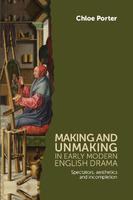Making and Unmaking in Early Modern English Drama - Spectators, Aesthetics and Incompletion
| dc.contributor.author | Porter, Chloe | |
| dc.date.accessioned | 2018-06-27 23:55 | |
| dc.date.accessioned | 2014-12-31 23:55:55 | |
| dc.date.accessioned | 2019-12-03 08:32:13 | |
| dc.date.accessioned | 2020-04-01T14:47:38Z | |
| dc.date.available | 2020-04-01T14:47:38Z | |
| dc.date.issued | 2014 | |
| dc.identifier | 469309 | |
| dc.identifier | OCN: 1030815977 | en_US |
| dc.identifier.uri | http://library.oapen.org/handle/20.500.12657/33467 | |
| dc.description.abstract | Exploring the significance of visual things that are 'under construction' in works by playwrights. Illustrated with examples, it opens up new interpretations of the place of aesthetic form in the early modern imagination. Why are early modern English dramatists preoccupied with unfinished processes of ‘making’ and ‘unmaking’? And what did ‘finished’ or ‘incomplete’ mean for spectators of plays and visual works in this period? Making and unmaking in early modern English drama is about the prevalence and significance of visual things that are ‘under construction’ in early modern plays. Contributing to challenges to the well-worn narrative of ‘iconophobic’ early modern English culture, it explores the drama as a part of a lively post-Reformation visual world. Interrogating the centrality of concepts of ‘fragmentation’ and ‘wholeness’ in critical approaches to this period, it opens up new interpretations of the place of aesthetic form in early modern culture. An interdisciplinary study, this book argues that the idea of ‘finish’ had transgressive associations in the early modern imagination. It centres on the depiction of incomplete visual practices in works by playwrights including Shakespeare, John Lyly, and Robert Greene. The first book of its kind to connect dramatists’ attitudes to the visual with questions of materiality, Making and Unmaking in Early Modern English Drama draws on a rich range of illustrated examples. Plays are discussed alongside contexts and themes, including iconoclasm, painting, sculpture, clothing and jewellery, automata, and invisibility. Asking what it meant for Shakespeare and his contemporaries to ‘begin’ or ‘end’ a literary or visual work, this book is invaluable for scholars and students of early modern English literature, drama, visual culture, material culture, theatre history, history and aesthetics. This title was made Open Access by libraries from around the world through Knowledge Unlatched. | |
| dc.language | English | |
| dc.subject.classification | thema EDItEUR::D Biography, Literature and Literary studies::DS Literature: history and criticism::DSG Literary studies: plays and playwrights | en_US |
| dc.subject.other | literature | |
| dc.subject.other | plays and playwrights | |
| dc.subject.other | Apelles | |
| dc.subject.other | Brazen head | |
| dc.subject.other | Early Modern English | |
| dc.subject.other | Early modern period | |
| dc.subject.other | England | |
| dc.subject.other | Iconoclasm | |
| dc.subject.other | Visual arts | |
| dc.subject.other | Visual culture | |
| dc.subject.other | William Shakespeare | |
| dc.title | Making and Unmaking in Early Modern English Drama - Spectators, Aesthetics and Incompletion | |
| dc.type | book | |
| oapen.identifier.doi | 10.26530/OAPEN_469309 | |
| oapen.relation.isPublishedBy | 6110b9b4-ba84-42ad-a0d8-f8d877957cdd | |
| oapen.relation.isFundedBy | b818ba9d-2dd9-4fd7-a364-7f305aef7ee9 | |
| oapen.relation.isbn | 9780719084973 | |
| oapen.collection | Knowledge Unlatched (KU) | |
| oapen.pages | 240 | |
| oapen.place.publication | Manchester, UK | |
| oapen.grant.program | KU Pilot | |
| oapen.remark.public | Relevant Wikipedia pages: Apelles - https://en.wikipedia.org/wiki/Apelles; Brazen head - https://en.wikipedia.org/wiki/Brazen_head; Early Modern English - https://en.wikipedia.org/wiki/Early_Modern_English; Early modern period - https://en.wikipedia.org/wiki/Early_modern_period; England - https://en.wikipedia.org/wiki/England; Iconoclasm - https://en.wikipedia.org/wiki/Iconoclasm; Visual arts - https://en.wikipedia.org/wiki/Visual_arts; Visual culture - https://en.wikipedia.org/wiki/Visual_culture; William Shakespeare - https://en.wikipedia.org/wiki/William_Shakespeare | |
| oapen.identifier.ocn | 1030815977 |

